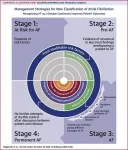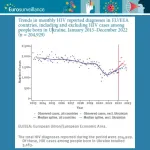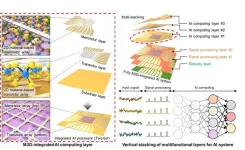(Press-News.org) AMHERST, Mass. – University of Massachusetts Amherst civil and environmental engineers have determined the factors that may help identify the schools and daycare centers at greatest risk for elevated levels of lead in drinking water. The most telling characteristic for schools in Massachusetts is building age, with facilities built in the 1960s and 1970s—nearly a third of the facilities tested—at the greatest risk for having dangerously high water lead levels.
There is no safe exposure level to lead. The Massachusetts Department of Environmental Protection (MassDEP) recommends that schools and childcare facilities achieve the lowest lead levels possible, with a goal of 1 ppb (parts per billion) or less, often the lowest measurement that a laboratory can make. Childhood exposure can cause brain and nervous system damage, slowed growth and development, learning and behavioral problems, and hearing and speech issues. (In fact, today, the Environmental Protection Agency announced proposed changes to the Lead and Copper Rule Improvements.)
The UMass study, published in the American Water Works Association’s journal Water Science, compared water lead-level data to a myriad of other characteristics that could influence these levels. “Is it certain types of fixtures? Is it certain types of buildings? Is it certain places? Is the chemistry of the water supply? Is there anything about the water treatment process?” says Emily Kumpel, one of the study authors and assistant professor of civil and environmental engineering at UMass Amherst.
Building age was the most important contributing factor, for a few reasons. Legislation has been passed over the years to improve the safety of school water. The federal Safe Drinking Water Act Amendment in 1986 required the use of “lead-free” piping, solder and flux in buildings. The definition of “lead-free” was then refined to more stringent levels in 2011.
Kumpel explains that there is a clear “before” and “after” around each of these time points: 50% of water samples from buildings constructed in 1986 and earlier had a water lead level of 2.1 ppb or higher and 13.7% of samples were greater than 15 parts per billion (or 0.0015 mg of lead per liter of water). After 1986, this declined so that half of samples had one ppb or less of lead, and only 4.6% of samples had lead levels higher than 15 ppb.
Importantly, these results represent water lead levels captured at “first draw,” meaning the water had been stagnant in the pipes overnight. The pattern was similar when looking at samples after the pipes had been flushed for 30 seconds, though less pronounced and with significantly lower lead levels after flushing.
Buildings constructed in the 1960s and 1970s—about 30% of all schools tested—were the most likely to have faucets, water fountains or other fixtures with elevated water lead levels at first draw. Half of the first draw water samples taken from schools built in these decades had lead concentrations at or above 2.8 and 2.9 ppb respectively. Plus, 16% of fixtures in 1960s buildings and 19.5% of fixtures in 1970s buildings had first draw levels over 15 ppb.
“That means that if you go into a facility built in the ’60s or ’70s and are the first one to get a glass of water in the morning or after a long school break, you’d have a high chance of it having a dangerously high level of lead. However, if the tap was flushed or had been used throughout the day, this would drop substantially. This is why flushing or other remediation actions are important,” Kumpel says.
Schools built in the 1950s and 1980s were also at slightly lower, but still elevated, risk.
Kumpel explains that this reflects certain construction decisions that were made in particular places at particular times. She also notes that trends in Massachusetts likely extend to other parts of New England that aren’t so geographically different and likely had similar building trends and best practices over the years.
The study’s data came from the Assistance Program for Lead in School Drinking Water, a MassDEP and UMass Amherst water monitoring collaboration that began in 2016. This initiative now has information from more than 1,500 schools and childcare facilities. “This publicly available large data set has been used for previous studies as well, and provides a basis for facilities to take action to protect children’s health, including applying for funding to install filtered bottle fill stations under the Massachusetts School Water Improvement Grant (SWIG) program,” notes John Tobiason, professor and head of the UMass Amherst civil and environmental engineering department, who leads the UMass work in support of the MassDEP initiative and is a co-author on this paper.
Part of this current analysis of the results from MassDEP’s voluntary testing program included evaluating if the results may also serve a predictive purpose by identifying the risk factors for elevated water lead levels.
“As of last year, around 60% [of Massachusetts schools] have had sampling done and reported to this public database, but 40% have not, though each month more schools and childcare facilities are testing,” says Kumpel. “That was what we were trying to get at with this model: of those that haven’t yet tested, can we prioritize the places that we might need to look at the most? Using these factors, can we then predict where we should make sure to follow up?”
There are obvious implications for school administrators and legislators looking to enact environmental protections, but what are the takeaways for parents?
“It’s close to home for me as someone with young children,” says Kumpel. “But I’m also an engineer that works particularly on water distribution systems and providing safe tap water. This is why there are programs to test the water and report results, that way you can have the assurance that there is monitoring. This is where, as engineers, we strive to achieve due diligence and transparency.” Where lead was detected, technical assistance was offered for remediation actions, including help in applying for the SWIG grants for water bottle filling stations, she adds.
Her advice: stay informed. Massachusetts makes it particularly easy to do that. “Massachusetts has made the data available in a public database,” she says. “See if your child’s school or daycare has been tested. There is this free testing program so, as a parent, it could be advocating that your childcare provider or school sign up for the testing program and get that information.”
Contact:
Emily Kumpel, ekumpel@umass.edu
Julia Westbrook, jwestbrook@umass.edu 413-545-0149
Emily Kumpel and John Tobiason are also available to comment on the EPA's Proposed Lead and Copper Rule Improvements.
END
Unsafe lead levels in school drinking water: new UMass Amherst study IDs building risk factors
Half of faucets in MA schools built in the 1960s and 70s could be a source of elevated lead levels; research helps identify facilities at the greatest risk
2023-11-30
ELSE PRESS RELEASES FROM THIS DATE:
Chinstrap penguins asleep thousands of times per day, but only for seconds at a time
2023-11-30
In the wild, nesting chinstrap penguins get more than 11 hours of sleep per day – but not all at once. According to a new study, these birds nod off thousands of times per day, but for only around 4 seconds at a time, cumulatively accruing their daily sleep needs while remaining continuously vigilant over their nests. Sleep seems to be ubiquitous throughout the animal kingdom. Typically characterized by immobility and the relative loss of ability to sense and respond to the surrounding environment, sleep can render animals vulnerable to predation. In humans, insufficient sleep can lead to nodding off, the seconds-long interruption of wakefulness by eye closure, and sleep-related ...
A Neptune-mass exoplanet found closely orbiting a very low-mass M dwarf star
2023-11-30
The discovery of a Neptune-mass exoplanet orbiting the very low-mass M dwarf star LHS 3154 challenges theoretical models of planet formation, according to a new study. The planet, which has a mass at least 13 times that of Earth, tightly orbits a star 9 times less massive than the Sun, demonstrating that small stars can sometimes host larger planets than was previously thought. Planets form in the dense circumstellar discs of gas and dust that surround newborn stars. The amount of material in these structures determines how massive the planets that form ...
Two teosintes made modern maize
2023-11-30
Broad genetic sampling of maize and its teosinte grass ancestors reveals evidence of wild admixture during the crop’s initial domestication and dispersal, according to a new study. The findings clarify the contentious origin of modern maize and raise new questions about the anthropogenic mechanisms underlying its spread throughout the Americas. The domestication of crops transformed human culture. For many crops, the wild plants that modern domesticates are most closely related to can be readily identified by morphological and genetic similarities. Yet, despite its global agricultural importance, the ancestry of modern maize has long ...
A mixed origin made maize successful
2023-11-30
Maize is one of the world’s most widely grown crops. It is used for both human and animal foods and holds great cultural significance, especially for indigenous peoples in the Americas. Yet despite its importance, the origins of the grain have been hotly debated for more than a century. Now new research, published Dec. 1 in Science, shows that all modern maize descends from a hybrid created just over 5000 years ago in central Mexico, thousands of years after the plant was first domesticated.
The ...
Discovery of planet too big for its sun throws off solar system formation models
2023-11-30
UNIVERSITY PARK, Pa. – The discovery of a planet that is far too massive for its sun is calling into question what was previously understood about the formation of planets and their solar systems, according to Penn State researchers.
In a paper published online today (Nov. 30) in the journal Science, researchers report the discovery of a planet more than 13 times as massive as Earth orbiting the “ultracool” star LHS 3154, which itself is nine times less massive than the sun. The mass ratio of the newly found planet with its host star is more than 100 times higher than that of Earth and the sun.
The finding reveals the most massive known ...
Early rhythm control, lifestyle modification and more tailored stroke risk assessment are top goals in managing atrial fibrillation
2023-11-30
The American College of Cardiology (ACC) and the American Heart Association (AHA), along with several other leading medical associations, have issued a new guideline for preventing and optimally managing atrial fibrillation (AFib). The guideline was jointly published today in the Journal of the American College of Cardiology and Circulation.
Atrial fibrillation, or AFib, is the most common type of heart rhythm disorder (arrhythmia), affecting over 6 million Americans, and the number is expected to double by 2030. AFib causes a variety of symptoms, including fast ...
Carbon dioxide becomes more potent as climate changes, study finds
2023-11-30
Embargoed: Not for Release Until 2:00 pm U.S. Eastern Time Thursday, 30 November 2023.
A team of scientists found that carbon dioxide becomes a more potent greenhouse gas as more is released into the atmosphere.
The new study, led by scientists at the University of Miami Rosenstiel School of Marine, Atmospheric, Science, was published in Science and comes as world leaders meet in Dubai, United Arab Emirates, this week for the United Nations Climate Change Conference COP28.
“Our finding means that ...
Researchers extend non-line-of-sight imaging towards longer wavelengths
2023-11-30
WASHINGTON — Emerging technologies for non-line-of-sight imaging can detect objects even if they are around a corner or behind a wall. In new work, researchers use a new type of detector to extend this method from visible light into near and mid-infrared wavelengths, an advance that could be especially useful for unmanned vehicles, robotic vision, endoscopy and other applications.
“Infrared non-line-of-sight imaging can improve the safety and efficiency of unmanned vehicles by helping them detect and navigate around obstacles that are not directly visible,” said Xiaolong Hu from Tianjin University in China. His team collaborated with a group ...
EU/EEA: HIV diagnoses rise for the first time in a decade
2023-11-30
Across the 30 countries of the European Union and European Economic Area (EU/EEA), 22,995 new HIV diagnoses were reported in 2022. Almost every second new HIV diagnosis (49%, n=11,103) was among migrants, i.e. among people who were not born in in the country they were diagnosed in. born abroad from the country of their diagnosis.
In the aftermath of Russia’s invasion of Ukraine in 2022, more than 4 million Ukrainians took refuge in countries of the European Union and European Economic Area (EU/EEA). In a rapid communication published in Eurosurveillance prior to World AIDS Day 2023 on 1 December, Reyes-Urueña et al. look at most recent surveillance data ...
2D material reshapes 3D electronics for AI hardware
2023-11-30
Multifunctional computer chips have evolved to do more with integrated sensors, processors, memory and other specialized components. However, as chips have expanded, the time required to move information between functional components has also grown.
“Think of it like building a house,” said Sang-Hoon Bae, an assistant professor of mechanical engineering and materials science at the McKelvey School of Engineering at Washington University in St. Louis. “You build out laterally and up vertically to get more ...
LAST 30 PRESS RELEASES:
S-species-stimulated deep reconstruction of ultra-homogeneous CuS nanosheets for efficient HMF electrooxidation
Mechanical and corrosion behavior of additively manufactured NiTi shape memory alloys
New discovery rewrites the rules of antigen presentation
Researchers achieve chain-length control of fatty acid biosynthesis in yeast
Water interactions in molecular sieve catalysis: Framework evolution and reaction modulation
Shark biology breakthrough: Study tracks tiger sharks to Maui mating hub
Mysterious iron ‘bar’ discovered in famous nebula
World-first tool reduces harmful engagement with AI-generated explicit images
Learning about public consensus on climate change does little to boost people’s support for action, study shows
Sylvester Cancer Tip Sheet for January 2026
The Global Ocean Ship-Based Hydrographic Investigations Program (GO-SHIP) receives the Ocean Observing Team Award
Elva Escobar Briones selected for The Oceanography Society Mentoring Award
Why a life-threatening sedative is being prescribed more often for seniors
Findings suggest that certain medications for Type 2 diabetes reduce risk of dementia
UC Riverside scientists win 2025 Buchalter Cosmology Prize
SETI Institute opens call for nominations for the 2026 Tarter Award
Novel theranostic model shows curative potential for gastric and pancreatic tumors
How beige fat keeps blood pressure in check
Fossils reveal ‘latitudinal traps’ that increased extinction risk for marine species
Review: The opportunities and risks of AI in mental health research and care
New map reveals features of Antarctic’s ice-covered landscape
Beige fat promotes healthy vascular function and blood pressure in mice
Chronic low-dose pesticide exposure reduces the life span of wild lake fish, China-based study shows
Tiny earthquakes reveal hidden faults under Northern California
Long-term pesticide exposure accelerates aging and shortens lifespan in fish
Professor Tae-Woo Lee's research group develops groundbreaking perovskite display technology demonstrating the highest efficiency and industry-level operational lifetime
The “broker” family helps tidy up the cell
Ecology: Mummified cheetahs discovery gives hope for species’ Arabic reintroduction
Researchers survey the ADHD coaching boom
Air pollution and cardiac remodeling and function in patients with breast cancer
[Press-News.org] Unsafe lead levels in school drinking water: new UMass Amherst study IDs building risk factorsHalf of faucets in MA schools built in the 1960s and 70s could be a source of elevated lead levels; research helps identify facilities at the greatest risk






